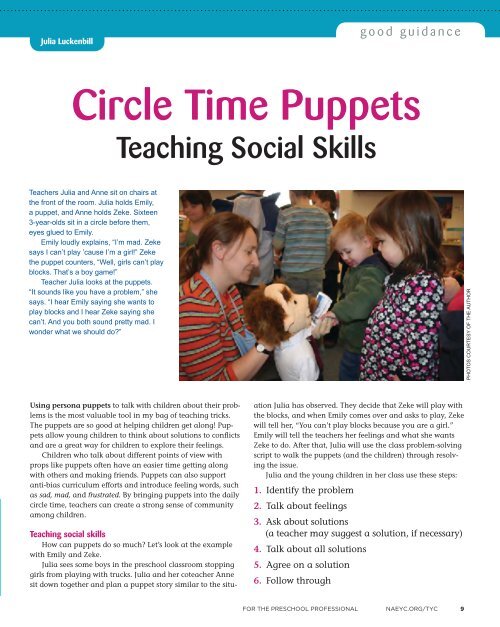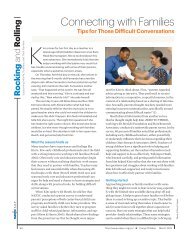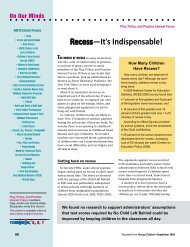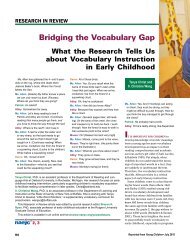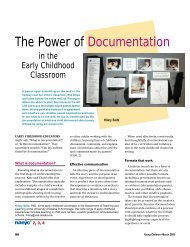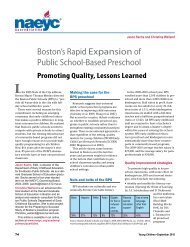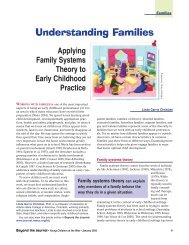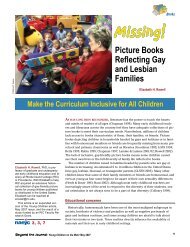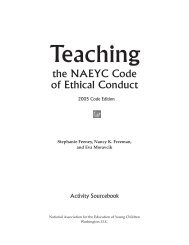Circle Time Puppets: Teaching Social Skills
Circle Time Puppets: Teaching Social Skills
Circle Time Puppets: Teaching Social Skills
You also want an ePaper? Increase the reach of your titles
YUMPU automatically turns print PDFs into web optimized ePapers that Google loves.
Julia Luckenbill<br />
teachers Julia and anne sit on chairs at<br />
the front of the room. Julia holds emily,<br />
a puppet, and anne holds zeke. sixteen<br />
3-year-olds sit in a circle before them,<br />
eyes glued to emily.<br />
emily loudly explains, “i’m mad. zeke<br />
says i can’t play ’cause i’m a girl!” zeke<br />
the puppet counters, “well, girls can’t play<br />
blocks. that’s a boy game!”<br />
teacher Julia looks at the puppets.<br />
“it sounds like you have a problem,” she<br />
says. “i hear emily saying she wants to<br />
play blocks and i hear zeke saying she<br />
can’t. and you both sound pretty mad. i<br />
wonder what we should do?”<br />
good guidance<br />
<strong>Circle</strong> <strong>Time</strong> <strong>Puppets</strong><br />
<strong>Teaching</strong> <strong>Social</strong> <strong>Skills</strong><br />
Using persona puppets to talk with children about their problems<br />
is the most valuable tool in my bag of teaching tricks.<br />
The puppets are so good at helping children get along! <strong>Puppets</strong><br />
allow young children to think about solutions to conflicts<br />
and are a great way for children to explore their feelings.<br />
Children who talk about different points of view with<br />
props like puppets often have an easier time getting along<br />
with others and making friends. <strong>Puppets</strong> can also support<br />
anti-bias curriculum efforts and introduce feeling words, such<br />
as sad, mad, and frustrated. By bringing puppets into the daily<br />
circle time, teachers can create a strong sense of community<br />
among children.<br />
<strong>Teaching</strong> social skills<br />
How can puppets do so much? Let’s look at the example<br />
with Emily and Zeke.<br />
Julia sees some boys in the preschool classroom stopping<br />
girls from playing with trucks. Julia and her coteacher Anne<br />
sit down together and plan a puppet story similar to the situ-<br />
ation Julia has observed. They decide that Zeke will play with<br />
the blocks, and when Emily comes over and asks to play, Zeke<br />
will tell her, “You can’t play blocks because you are a girl.”<br />
Emily will tell the teachers her feelings and what she wants<br />
Zeke to do. After that, Julia will use the class problem-solving<br />
script to walk the puppets (and the children) through resolving<br />
the issue.<br />
Julia and the young children in her class use these steps:<br />
1. Identify the problem<br />
2. Talk about feelings<br />
3. Ask about solutions<br />
(a teacher may suggest a solution, if necessary)<br />
4. Talk about all solutions<br />
5. Agree on a solution<br />
6. Follow through<br />
FOR THE PRESCHOOL PROFESSIONAL NAEYC.ORG/TYC 9<br />
photos courtesy of the author
good guidance<br />
At the beginning of circle time, Julia identifies the conflict<br />
and shows how the puppets feel. Next, she asks for solutions<br />
from Anne and the children. By asking another teacher to<br />
help the puppets find solutions, Julia models seeking help<br />
from teachers. She also gets some<br />
grown-up ideas for solving the<br />
problem.<br />
Julia asks, “anne, do you have any<br />
ideas about what zeke and emily<br />
should do?”<br />
anne replies, “well, i think girls<br />
can play with blocks, because i’m a<br />
girl and i like to play with blocks and<br />
trucks.”<br />
Julia says, “i hear anne saying<br />
that she’s a girl and she plays with<br />
lots of kinds of toys, zeke. she’s<br />
saying that girls can play with blocks.<br />
Let’s ask the children what they<br />
think. we’ll go around the circle and<br />
give anyone a turn who wants one.”<br />
several children have ideas.<br />
some of them agree with anne. shoshana<br />
says, “i’m a girl and i play with<br />
blocks too!” then shoshana goes<br />
a bit off-topic, saying, “i saw a truck<br />
outside.”<br />
emily gently guides the children<br />
back to the topic, saying, “i like to<br />
look at trucks too, but i like to play with blocks even more, and<br />
zeke says i can’t! what should i do?”<br />
The class makes a new class rule: Everyone can play with<br />
all of the toys. Anne writes the rule on paper and posts it<br />
on the wall. Emily and Zeke agree to play blocks and trucks<br />
together, and Zeke apologizes: “I didn’t know girls could play<br />
with blocks. I’m sorry for hurting your feelings.”<br />
Dealing with feelings<br />
Teachers can also use puppets to help children process difficult<br />
feelings. Examples from the children’s play can inspire<br />
your stories, but never shame or make fun of children.<br />
In this next example, a teacher notices that Kamiah, an<br />
older preschooler, is very sad and refuses to play. Her mother<br />
tells the teachers that it is because she is afraid of going to<br />
kindergarten. This becomes the focus of the puppet show.<br />
Families need strategies for teaching social skills to their children. Sign<br />
and make copies of the Message in a Backpack on page 12 to send<br />
home. It’s also available online (in English and Spanish) at naeyc.org/tyc.<br />
10 TEACHING YOUNG CHILDREN VOL 4 NO 4<br />
Again, the teachers, this time Julia and Stephanie, plan a<br />
story. They don’t need two persona puppets since this is not a<br />
conflict.<br />
“i have a secret,” emily says in a stage<br />
whisper.<br />
“what’s that?” asks teacher Julia.<br />
“i’m feeling sad and scared, but it’s<br />
for a silly reason.”<br />
“can you tell me why?” asks Julia.<br />
“yeah … i’m scared of going to<br />
kindergarten.”<br />
“why?”<br />
emily says, “’cause i think maybe<br />
the teacher will be mean or i won’t<br />
have any friends or i won’t be able to<br />
find the potty … all kinds of things!”<br />
“oh,” replies Julia. “well, i bet a lot<br />
of children feel that way. but there are<br />
things we can do to make it less scary.<br />
does anyone have any ideas? Let’s go<br />
around the circle.”<br />
The children eagerly tell Emily<br />
not to worry, that she can meet her<br />
nice new teacher—they have. Many<br />
of the children share their ideas for<br />
what to do when you are scared, like<br />
bringing a stuffed animal or taking<br />
deep breaths. Teachers Stephanie<br />
and Julia write down the children’s ideas and add a few of<br />
their own, such as asking the kindergarten teacher to help<br />
them make a friend and asking another child where to find<br />
the bathroom. The teachers also share the list with all of the<br />
children’s families by leaving it posted on the wall.<br />
Using puppets in your classroom<br />
Using puppets to tell scripted stories is not a new idea, but<br />
this technique is seldom used in preschool classrooms. Some<br />
teachers may feel scared, not know what to say, or feel they<br />
can’t make the performance seem real, so they don’t use puppets.<br />
Yet this skill is both easy to learn and an effective and<br />
positive way to teach social skills.<br />
It sounds like a good idea, but how do you get good at it?<br />
How do you make the puppets seem real? How do you cope<br />
with the discomfort that comes with acting? Here are some<br />
tips for using puppets in your classroom.<br />
Preparing for the puppet show<br />
• Try out each puppet before buying it, keeping<br />
your audience in mind. Does your hand fit<br />
well inside the puppet? Is your puppet friendly<br />
looking? Look for faces that can change to show<br />
expressions and hands or paws that move.
• Select diverse puppets with care. Include a range of cultures,<br />
abilities, and backgrounds. Consider using animals too.<br />
This shows children that all kinds of folks can be friends.<br />
• Think about your puppet’s personality. Is he fearful, feisty,<br />
or flexible? A range of puppets gives every child “someone<br />
like me.”<br />
• Use different voices for puppets. Try making your voice higher,<br />
lower, quicker, or slower. Practice that voice in conversation<br />
with another teacher before performing at circle time.<br />
• Write a script if you are nervous. Even if you don’t use the<br />
script, it will help you remember what you want to say.<br />
During the performance<br />
• Use childlike language. Your persona puppet will seem<br />
more like a real child if she uses words and sentences similar<br />
to those the children use.<br />
• Make sure each puppet has a range of experiences and<br />
behaviors. This way children won’t label puppets “bad” or<br />
“good.” Everyone has problems and successes.<br />
• Invite staff members and parents who speak another language<br />
to become puppeteers. The puppets can model dual<br />
language use and teach the children to try out new words<br />
in that language.<br />
� e Creative Curriculum®<br />
System for Preschool<br />
Every teacher. Every child. Every day.<br />
Every child is unique. Every teacher is, too. That’s why<br />
The Creative Curriculum ® System for Preschool offers<br />
comprehensive, research-based support that prepares both<br />
teachers and children for success, every step of the way.<br />
good guidance<br />
• Use real toys as props when acting out conflicts over<br />
things. For example, use real blocks if puppets are fighting<br />
over blocks.<br />
Just do it! You might feel on the spot at first, like the first<br />
time dancing or singing at circle time. But young children<br />
don’t judge you! The more you practice, the easier it gets.<br />
Conclusion<br />
I can’t imagine teaching preschool without puppets.<br />
When Emily talks about how being teased makes her feel<br />
mad, children gain perspective and their classroom behaviors<br />
change. Simply saying, “Remember how Emily felt when Zeke<br />
told her she couldn’t play?” and then pointing out children’s<br />
own solutions from the circle time (their class rules) works<br />
wonders. I also find that children are more likely to tell their<br />
fears and feelings to one of the puppets than to me.<br />
When something comes up in my classroom, whether it<br />
is “You can’t play,” teasing, going to the hospital, expecting<br />
a new baby, or visiting the fire station, Emily the puppet<br />
and her friends talk about it at circle time. They share their<br />
feelings and shape solutions for our community. I hope that<br />
inviting a puppet to your circle is as useful and fun for you as<br />
it has been for our class.<br />
For an interactive look, visit <strong>Teaching</strong>Strategies.com/system or call us at 800.637.3652.


